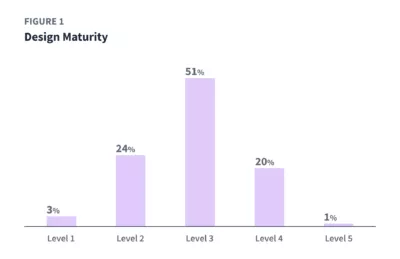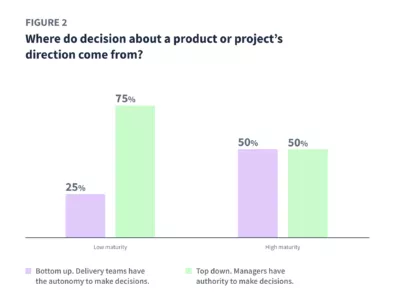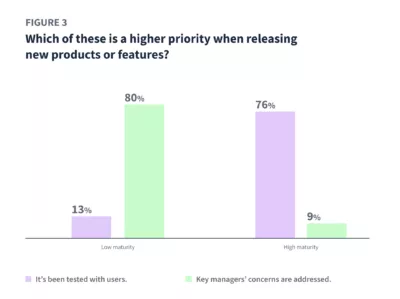15 Nov 2023
Customer excellence: upgrading your design team may not be the answer

If your firm wants to get better at design, you probably shouldn’t be trying to upgrade your design team.
-
Giles Colborne
Director of Strategy

‘Frankly, I don’t think our design team is good enough.’ The C-suite executive had waited until his head of design had left the room. Now he was ready to tell me what he really thought.
It was quite a list. Designers were doing the wrong things, were complaining about trifles, were failing to take the initiative, and were delivering work that was uninspiring.
Despite spending millions a year on design, the company’s customer experience was ranked as ‘average’ among its competitors.
That executive’s complaints echo what we hear from large organisations across Europe – there’s a sense that money is being wasted on results that aren’t good enough.
From good to great
In the past decade, large organisations have made a major investment in their design teams. Once, design was seen as a luxury. Today it’s regarded as essential for creating the digital services that drive modern organisations.
Over the past two years, we have gathered data from 200 European companies to compare design maturity with performance.
We found that 98% achieved level 2 maturity or higher – meaning they at least had a dedicated UX design team that would be able to catch the worst usability fails.
The majority of organisations we’ve looked at (51%, see Fig. 1), had reached Level 3. At this level, services are usable most of the time. Sometimes they’re great, sometimes they’re not.
But we found that the true rewards were reserved for the highest performing organisations. These were firms that achieved Level 4 or 5 on our maturity scale. They grew nine times faster than the rest.
The price of survival
The problem facing companies at Level 3, is that ‘usable’ is no longer enough to stand out from the crowd.
In a world where people expect to bank online, shop online, and tax their car online, ‘usable’ is the minimum standard for digital services.
At Level 3, organisations’ design budgets aren’t being spent on success; they’re being spent on survival.
Stuck in the ‘messy middle’
Which brings us back to our C-suite executive’s complaints about his design team. His firm’s design maturity had plateaued at Level 3.
Level 3 companies appear to have all the elements of a great design organisation in place (specialist roles, facilities and tooling, processes). But they get middling results.

We call this ‘the messy middle’ because, with so much being done right, it can be hard to figure out what’s going wrong.
To understand that, you need to look at the high-maturity companies.
Culture clash
The C-suite executive’s complaints described a culture clash between the design team and the rest of the organisation. Without realising it, he had pinpointed the problem.
The difference between level 3 organisations and those that make it to the magic Level 4.5 is not in the design team.
High-maturity organisations have fixed governance. The interaction between their design teams and senior management is far better.
A different theory of success
Senior managers in mid-maturity organisations are trying to juggle multiple priorities – shareholder value, cost reduction, departmental politics, and customer value.
We call this the ‘balanced scorecard’ theory of success. The idea is to always push forward on multiple fronts.
In reality, it leads to culture clash and friction throughout the organisation.
In contrast, high maturity organisations see all these priorities as coming from, or operating in support of, delivering customer value.
By focussing on customer value, these organisations believe they will:
- have fewer complaints, support calls, and regulatory challenges to manage
- be able to spend less on sales and marketing because they will have a clearer message and stronger word of mouth
- act faster and suffer less political tension as departments are aligned to a clear goal
- see shareholder value grow because of strong sales, low costs, and a clear message to markets
This theory of success erases culture clash, bringing clarity and alignment between senior managers and those on the front lines. With it comes a different approach to governance.
Less intervention, more control
Modern governance is about moving faster by devolving decision making while retaining control.
The question of governance becomes far simpler in organisations that focus on customer value, rather than those where executives are constantly having to intervene to keep the scorecard balanced.
This makes it easier for managers to devolve decision making. So long as teams can show they are aligned to organisational strategy, are making evidence-led decisions, and are following organisational process, managers can trust them to get results.
It also becomes easier to set policy, ratify decisions, manage talent, and prioritise resources when the organisational theory of success is clear.
Modern governance isn’t hands-free. Senior management need to make sure their delivery teams understand company strategy, use resources well, and follow policies and procedures. These are their tools of control.
By the numbers
Our study showed this is exactly what is happening in high maturity organisations.
In high maturity organisations, decision making was split evenly (50% each) between senior management and delivery teams. In low maturity organisations managers made far more of the decisions (75%) (see Fig. 2).
What’s more the content of those decisions was different. High maturity organisations focussed on evidence from user research. Low maturity organisations prioritised the opinions of key managers (see Fig. 3).


Their decision making was faster, too (65% of high-maturity organisations reported they were able to make changes months, whereas 69% said they took years).
By focussing on the key question – ‘can you prove it will work for our customers?’ – managers in high-maturity organisations were able to devolve a considerable amount of decision making.
Show don’t tell
Of course, there’s more to governance than delivery oversight. Resource allocation, portfolio management, compliance, and policy are all part of the mix.
In large organisations this often adds up to a complex picture. Faced with that complexity, boards worry about the risk of changes to governance.
What’s needed is evidence. So, rather than conduct a seminar on the theory of success, we advise a hands-on approach.
Set up a team to operate under different governance rules. Train managers and stakeholders (such as compliance teams) in the customer-led approach. Deliver a project and show success – faster delivery, better outcomes.
With a project successfully delivered, it is easier to move on to more general issues such as resource allocation, portfolio management, and compliance (our approach to introducing ‘Evidence Based Compliance’ also begins with project delivery).
We also believe its easier to do this if your team is seeded with outsiders who don’t have the same pressure to conform and who are expert in the new approach.
As consultants we would say that, wouldn’t we? But we find teams buckle easily if they’re not supported.
One senior manager we worked with summed up his experience: ‘all of the things that I thought would add to our delivery time turned out to be the things that made us go faster.’
In the face of scepticism, it takes experience and discipline to stick to a new way of working.
The new reality
While most firms espouse a customer centred approach, the balanced scorecard theory of success means that they more often focus on other priorities.
That lack of clarity, combined with a lack of familiarity of modern governance methods means their design output is average.
In an uncertain low-growth, high-inflation, post-pandemic world, organisations need to get out of the messy middle. Otherwise they risk being picked off by high-maturity competitors.
The change in thinking needs to happen outside of the design team.
Key points
- Design has become an essential for organisations in the digital age.
- The benefits are unevenly distributed – the big rewards only come for high maturity organisations.
- To get beyond mid-level maturity, organisations need to focus on governance.
- A single minded ‘theory of business’ that focuses customer value is more effective than trying to ‘balance the scorecard’.
- Modern governance allows senior executives to devolve decision making closer to the customer, without giving up control.
- To fix governance, begin by establishing ‘pathfinder’ projects and manage them with modern governance methods to show what’s possible.
You can read more about our research in our white paper ‘The state of Customer Centricity’.




